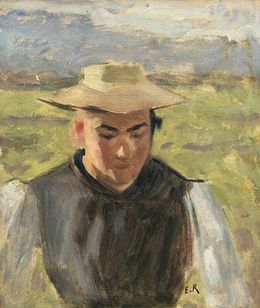
Etude d'une paysanne
Edouard John Ravel
Painting - 20 x 17 x 0.3 cm Painting - 7.9 x 6.7 x 0.1 inch
Sold
Jean-Édouard Ravel, also known as Édouard John Ravel or simply Édouard Ravel, born in Versoix on March 5, 1847 and died in Geneva Plainpalais on March 8, 1920, was a Swiss painter, engraver and illustrator.
Édouard Ravel, uncle of the composer Maurice Ravel, began his career with an apprenticeship within the framework of the “Fabrique” which then trained decorators for watchmaking and then opened his own enamel workshop. before enrolling at the Geneva School of Art, where he studied under Barthélemy Menn and Jacques Alfred van Muyden in Geneva.
A versatile artist, Ravel uses many techniques: miniature, drawing, watercolour, pastel, etching and drypoint, posters, easel painting and monumental decoration. His multiple talents allow him to cultivate the genre scene, the portrait, the painting of animals, the landscape, the painting of history and allegory.
He is part of the Federal Commission of Fine Arts and teaches art applied to industry and art history at the School of Fine Arts in Geneva, but finds his way in Valais, especially in Évolène , traveling from 1885 the Val d'Hérens and that of Anniviers in search of picturesque views.
He began to exhibit at the Paris Salon from 1878. There was an honorable mention in 1879 for his first masterpiece, The School of Drawing, perhaps inspired by the Geneva institution called "The School of demoiselles” created in 1852 and reserved for young girls, and which operated until 1870. It received a bronze medal at the Universal Exhibition of 1889 in Paris.
In the field of history painting, he distinguished himself in particular with his Justice chez les Helvètes, which in 1891 earned him third prize in the first competition for the decoration of the Federal Court of Montbenon in Lausanne. This composition is then developed on a large canvas given to the Geneva Hospital and then distributed by a postcard; it was taken up again in 1904 to illustrate the History of Switzerland by William Rosier.
Édouard Ravel obtained various commissions for monumental decoration, notably for the Town Hall of Plainpalais, in Geneva, where the artist signed a large composition in 1894 illustrating the market gardens of the city, or for the communal hall of Plainpalais built by the architect Joseph Marshall in 1908-1909, where in 1912 he created a large canvas called Celestial Harmonies.
Several paintings by Édouard Ravel are kept in Maurice Ravel's residence in Montfort-l'Amaury, the Belvedere: in particular three family portraits in the music room (Maurice Ravel as a child, Édouard Ravel - his younger brother - as a child, and the mother of the composer, Marie Delouart). An alleged portrait of Maurice Ravel's father by his brother was acquired in 2017 by the Friends of Maurice Ravel.
An artist long relegated to the purgatory of the forgotten because he did not do "modern painting", Ravel nevertheless showed great craftsmanship and multiple talents. It is now gradually being rehabilitated. Thus, it was not until 2014 that a French gallery owner organized his first exhibition in Morges since 1928.

Painting - 20 x 17 x 0.3 cm Painting - 7.9 x 6.7 x 0.1 inch
Sold
What are their 3 main works?
When was Edouard John Ravel born?